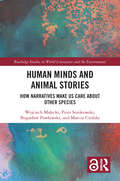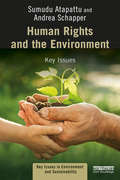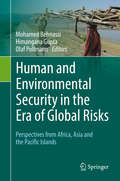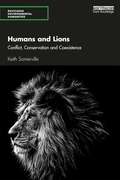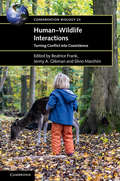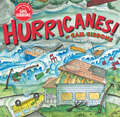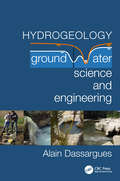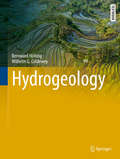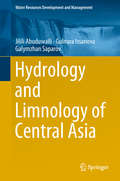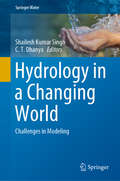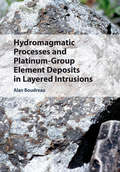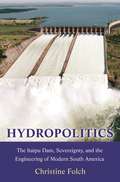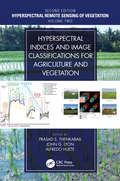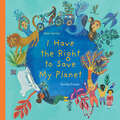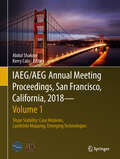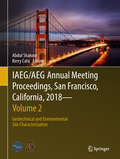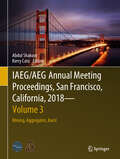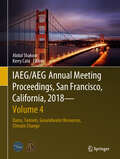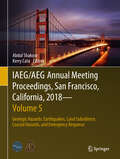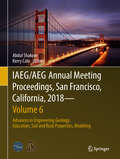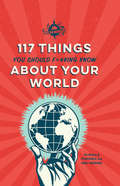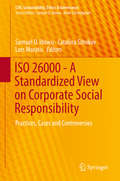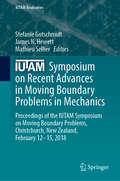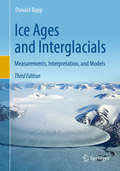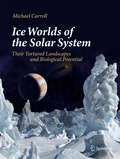- Table View
- List View
Human Minds and Animal Stories: How Narratives Make Us Care About Other Species (Routledge Studies in World Literatures and the Environment)
by Wojciech Małecki Piotr Sorokowski Bogusław Pawłowski Marcin CieńskiThe power of stories to raise our concern for animals has been postulated throughout history by countless scholars, activists, and writers, including such greats as Thomas Hardy and Leo Tolstoy. This is the first book to investigate that power and explain the psychological and cultural mechanisms behind it. It does so by presenting the results of an experimental project that involved thousands of participants, texts representing various genres and national literatures, and the cooperation of an internationally-acclaimed bestselling author. Combining psychological research with insights from animal studies, ecocriticism and other fields in the environmental humanities, the book not only provides evidence that animal stories can make us care for other species, but also shows that their effects are more complex and fascinating than we have ever thought. In this way, the book makes a groundbreaking contribution to the study of relations between literature and the nonhuman world as well as to the study of how literature changes our minds and society. "As witnessed by novels like Black Beauty and Uncle Tom’s Cabin, a good story can move public opinion on contentious social issues. In Human Minds and Animal Stories a team of specialists in psychology, biology, and literature tells how they discovered the power of narratives to shift our views about the treatment of other species. Beautifully written and based on dozens of experiments with thousands of subjects, this book will appeal to animal advocates, researchers, and general readers looking for a compelling real-life detective story." - Hal Herzog, author of Some We Love, Some We Hate, Some We Eat : Why It’s So Hard To Think Straight About Animals
Human Rights and the Environment: Key Issues (Key Issues in Environment and Sustainability)
by Sumudu Atapattu Andrea SchapperThe field of human rights and the environment has grown phenomenally during the last few years and this textbook will be one of the first to encourage students to think critically about how many environmental issues lead to a violation of existing rights. Taking a socio-legal approach, this book will provide a good understanding of both human rights and environmental issues, as well as the limitations of each regime, and will explore the ways in which human rights law and institutions can be used to obtain relief for the victims of environmental degradation or of adverse effects of environmental policies. In addition, it will place an emphasis on climate change and climate policies to highlight the pros and cons of using a human rights framework and to underscore its importance in the context of climate change. As well as identifying emerging issues and areas for further research, each chapter will be rich in pedagogical features, including web links to further research and discussion questions for beyond the classroom. Combining their specialisms in law and politics, Atapattu and Schapper have developed a truly inter-disciplinary resource that will be essential for students of human rights, environmental studies, international law, international relations, politics, and philosophy.
Human and Environmental Security in the Era of Global Risks: Perspectives from Africa, Asia and the Pacific Islands
by Mohamed Behnassi Olaf Pollmann Himangana GuptaThis book discusses ways to deepen the debate on the linkages between global risks and human and environmental security. The approach put forward in this book is one of questioning the ability of existing concepts, regulatory frameworks, technologies and decision-making mechanisms to accurately deal with emerging risks to human and environmental security, and to act in the direction of effectively managing their impacts and fostering the resilience of concerned systems and resources. Empirical research findings from Africa, Asia and the Pacific Islands are provided.During the last decades the links between emerging risks and the security of humans and nature have been the object of considerable research and deliberations. However, it is only recently becoming an important focus of policy making and advocacy. In this contributed volume, it is presumed that the ability – or lack thereof – to make innovative conceptual frameworks, institutional and policy arrangements, and technological advances for managing the current emerging risks, will foster or undermine the environmental security, and consequently determine the future human security. Moreover, taking into account the links between environmental/climate security, human security and sustainability will help frame a new research agenda and potentially develop a broad range of responses to many delicate questions.
Humans and Lions: Conflict, Conservation and Coexistence (Routledge Environmental Humanities)
by Keith SomervilleThis book places lion conservation and the relationship between people and lions both in historical context and in the context of the contemporary politics of conservation in Africa. The killing of Cecil the Lion in July 2015 brought such issues to the public’s attention. Were lions threatened in the wild and what was the best form of conservation? How best can lions be saved from extinction in the wild in Africa amid rural poverty, precarious livelihoods for local communities and an expanding human population? This book traces man’s relationship with lions through history, from hominids, to the Romans, through colonial occupation and independence, to the present day. It concludes with an examination of the current crisis of conservation and the conflict between Western animal welfare concepts and sustainable development, thrown into sharp focus by the killing of Cecil the lion. Through this historical account, Keith Somerville provides a coherent, evidence-based assessment of current human-lion relations, providing context to the present situation. This book will be of interest to students and scholars of environmental and African history, wildlife conservation, environmental management and political ecology, as well as the general reader.
Human–Wildlife Interactions: Turning Conflict into Coexistence (Conservation Biology #23)
by Beatrice Frank Jenny A. Glikman Silvio MarchiniHuman-wildlife conflict (HWC) is one of the most complex and urgent issues facing wildlife management and conservation today. Originally focused on the ecology and economics of wildlife damage, the study and mitigation of HWC has gradually expanded its scope to incorporate the human dimensions of the whole spectrum of human-wildlife relationships, from conflict to coexistence. Having the conflict-to-coexistence continuum as its leitmotiv, this book explores a variety of theories and methods currently used to address human-wildlife interactions, illustrated by case studies from around the world. It presents some key concepts in the field, such as values, emotions, social identity and tolerance, and a variety of insights and solutions to turn conflict into coexistence, from individual level to national scales, including conservation marketing, incremental and radical innovation, strategic planning, and socio-ecological systems. This volume will be of interest to a wide range of readers, including academics, researchers, students, practitioners and policy-makers.
Hurricanes! (New Edition)
by Gail GibbonsWhat in the world is a hurricane? In this age of extreme weather, this newly updated edition of Gail Gibbons' informative introduction to hurricanes, with safety tips included, answers that question.Imagine a force that can toss boats around like toys, wash away bridges, create waves as high as eighteen feet, and change the shape of a shoreline. With fierce winds and torrential rains, hurricanes can do all of these things. In this newly revised edition, vetted by weather experts, Gail Gibbons introduces readers to the concepts of hurricane formation, classification, weather preparedness, and the ever-evolving technology that helps us try to predict the behavior of these powerful storms. Extensive updates include refined definitions for hurricane-related vocabulary, updated information about the wind speeds that define hurricane categories, information on emergency preparedness, and more. As these weather disturbances become more frequent and more powerful, Hurricanes is the perfect introduction for children to this important and timely topic.With her signature clear, colorful paintings and well-labeled diagrams, Gail Gibbons' nonfiction titles have been called ""staples of any collection" (Kirkus Reviews) and offer clear, accessible introductions to complex topics for young readers beginning to explore the world.
Hydrogeology: Groundwater Science and Engineering
by Alain DassarguesThis text combines the science and engineering of hydrogeology in an accessible, innovative style. As well as providing physical descriptions and characterisations of hydrogeological processes, it also sets out the corresponding mathematical equations for groundwater flow and solute/heat transport calculations. And, within this, the methodological and conceptual aspects for flow and contaminant transport modelling are discussed in detail. This comprehensive analysis forms the ideal textbook for graduate and undergraduate students interested in groundwater resources and engineering, and indeed its analyses can apply to researchers and professionals involved in the area.
Hydrogeology: Introduction To Applied Hydrogeology (Springer Textbooks in Earth Sciences, Geography and Environment)
by Bernward Hölting Wilhelm G. ColdeweyThis textbook provides a complete introduction to Hydrogeology. It is a comprehensive reference for earth science professionals involved in groundwater exploitation as well as for geotechnical engineers. This English translation of the German textbook "Hydrogeologie" by Hölting & Coldewey, which has been published in its 8th edition, provides insights into the sources and reservoirs of groundwater, the dynamics of fluid flow, and the physical and chemical composition of groundwater. It also gives an overview about the economic value of groundwater and its exploitation and use. A consistent use of the internationally accepted SI units as well as the formula symbols in the text contributes to the understandability.
Hydrology and Limnology of Central Asia (Water Resources Development and Management)
by Gulnura Issanova Jilili Abuduwaili Galymzhan SaparovThis book highlights the development of lake systems and water reservoirs as well as the impact of climate change on water resources in Central Asian countries. It provides information on the genesis of lake basins, physical and chemical properties of water in lakes, and the hydrological regimes (water balance and fluctuation levels) of lakes of Central Asia and Xinjiang. The book is useful for scientists and researchers whose work focuses on lakes and the use of natural resources, irrigation, hydropower and water supply, as well as for students and planners.
Hydrology in a Changing World: Challenges in Modeling (Springer Water)
by Shailesh Kumar Singh C. T. DhanyaThis book offers a comprehensive overview of the challenges in hydrological modeling. Hydrology, on both a local and global scale, has undergone dramatic changes, largely due to variations in climate, population growth and the associated land-use and land-cover changes. Written by experts in the field, the book provides decision-makers with a better understanding of the science, impacts, and consequences of these climate and land-use changes on hydrology. Further, offering insights into how the changing behavior of hydrological processes, related uncertainties and their evolution affect the modeling process, it is of interest for all researchers and practitioners using hydrological modeling.
Hydromagmatic Processes and Platinum-Group Element Deposits in Layered Intrusions
by Alan BoudreauThe role of hydrothermal fluids during the crystallization of layered intrusions and the ore deposits they contain has long been debated. This book summarizes the evidence for fluid-crystal-liquid (hydromagmatic) interactions and their importance for the understanding of the formation of platinum-group deposits in layered intrusions. It discusses the composition of igneous fluids in mafic magmatic systems, the generation and movement of these fluids in layered intrusions, their impact in altering the mineralogy and composition of the originally precipitated assemblages, and their role in the transport of the platinum-group elements (PGE). Using examples from the Bushveld complex of South Africa and other intrusions, this book provides a comprehensive overview of the hydromagmatic model for the origin of various features of layered intrusions. It is a useful reference for academic researchers and professional geologists working on economic mineral exploration, layered igneous intrusions, and hydrothermal metallogenesis.
Hydropolitics: The Itaipu Dam, Sovereignty, and the Engineering of Modern South America (Princeton Studies in Culture and Technology #20)
by Professor Christine FolchAn in-depth look at the people and institutions connected with the Itaipu Dam, the world’s biggest producer of renewable energyHydropolitics is a groundbreaking investigation of the world’s largest power plant and the ways the energy we use shapes politics and economics. Itaipu Binational Hydroelectric Dam straddles the Paraná River border that divides the two countries that equally co-own the dam, Brazil and Paraguay. It generates the carbon-free electricity that powers industry in both the giant of South America and one of the smallest economies of the region. Based on unprecedented access to energy decision makers, Christine Folch reveals how Paraguayans harness the dam to engineer wealth, power, and sovereignty, demonstrating how energy capture influences social structures.During the dam’s construction under the right-wing military government of Alfredo Stroessner and later during the leftist presidency of liberation theologian Fernando Lugo, the dam became central to debates about development, governance, and prosperity. Dams not only change landscapes; Folch asserts that the properties of water, transmuted by dams, change states. She argues that the dam converts water into electricity and money to produce hydropolitics through its physical infrastructure, the financial liquidity of energy monies, and the international legal agreements managing transboundary water resources between Brazil and Paraguay, and their neighbors Argentina, Bolivia, and Uruguay.Looking at the fraught political discussions about the future of the world’s single largest producer of renewable energy, Hydropolitics explores how this massive public works project touches the lives of all who are linked to it.
Hyperspectral Indices and Image Classifications for Agriculture and Vegetation (Hyperspectral Remote Sensing of Vegetation, Second Edition)
by Prasad S. Thenkabail, John G. Lyon and Alfredo HueteWritten by leading global experts, including pioneers in the field, the four-volume set on Hyperspectral Remote Sensing of Vegetation, Second Edition, reviews existing state-of- the-art knowledge, highlights advances made in different areas, and provides guidance for the appropriate use of hyperspectral data in the study and management of agricultural crops and natural vegetation.Volume II, Hyperspectral Indices and Image Classifications for Agriculture and Vegetation evaluates the performance of hyperspectral narrowband or imaging spectroscopy data with specific emphasis on the uses and applications of hyperspectral narrowband vegetation indices in characterizing, modeling, mapping, and monitoring agricultural crops and vegetation. This volume presents and discusses topics such as the non-invasive quantification of foliar pigments, leaf nitrogen concentration of cereal crop, the estimation of nitrogen content in crops and pastures, and forest leaf chlorophyll content, among others. The concluding chapter provides readers with useful guidance on the highlights and essence of Volume II through the editors’ perspective.Key Features of Volume II: Provides the fundamentals of hyperspectral narrowband vegetation indices and hyperspectral derivative vegetation indices and their applications in agriculture and vegetation studies. Discusses the latest advances in hyperspectral image classification methods and their applications. Explains the massively big hyperspectral sensing data processing on cloud computing architectures. Highlights the state-of-the-art methods in the field of hyperspectral narrowband vegetation indices for monitoring agriculture, vegetation, and their properties such as plant water content, nitrogen, chlorophyll, and others at leaf, canopy, field, and landscape scales. Includes best global expertise on hyperspectral remote sensing of agriculture, crop water use, plant species detection, crop productivity and water productivity mapping, and modeling.
I Have the Right to Save My Planet (I Have the Right #2)
by Alain SerresFrom the author and illustrator duo who created the award-winning I Have the Right to Be a Child comes this beautifully illustrated picture book about a child’s right to advocate for the environment they live in. All children have the right to learn about the world, to celebrate the water, air and sunshine, and to be curious about the animals and plants that live on our planet. All children also have the right to learn about endangered species, to be concerned about plastic in the ocean, and to understand what a changing climate means for our Earth. Scientists tell us that every living thing is connected. When we cut down forests, we destroy animal habitats. When we throw plastic in the garbage, it never really goes away. When we spray pesticides on our fruit and vegetables, we poison the earth, animals and ourselves. What can children do to help? All children can draw posters of endangered animals to raise awareness. All children can send a letter to the leader of their country, signed by every member of their family. All children can protest along with their parents. Children have the right to do all these things as proclaimed in the United Nations Convention on the Rights of the Child. All children have the right to try to help our Earth, in whatever ways they can. Told from the perspective of a child, this colorful and vibrant book explores what it means to be a child who dreams of a beautiful future for their planet. Correlates to the Common Core State Standards in English Language Arts: CCSS.ELA-LITERACY.RI.2.6 Identify the main purpose of a text, including what the author wants to answer, explain, or describe.
IAEG/AEG Annual Meeting Proceedings, San Francisco, California, 2018 - Volume 1: Slope Stability: Case Histories, Landslide Mapping, Emerging Technologies
by Abdul Shakoor Kerry CatoThis book is one out of six IAEG XIII Congress and AEG 61st Annual Meeting proceeding volumes, and deals with topics related to slope stability including case histories, landslide mapping, and emerging technologies. The theme of the IAEG/AEG Meeting, held in San Francisco from September 17-21, 2018, is Engineering Geology for a Sustainable World. The meeting proceedings analyze the dynamic role of engineering geology in our changing world. The meeting topics and subject areas of the six volumes are: Slope Stability: Case Histories, Landslide Mapping, Emerging Technologies; Geotechnical and Environmental Site Characterization; Mining, Aggregates, Karst; Dams, Tunnels, Groundwater Resources, Climate Change; Geologic Hazards: Earthquakes, Land Subsidence, Coastal Hazards, and Emergency Response; and Advances in Engineering Geology: Education, Soil and Rock Properties, Modeling.
IAEG/AEG Annual Meeting Proceedings, San Francisco, California, 2018 - Volume 2: Geotechnical and Environmental Site Characterization
by Abdul Shakoor Kerry CatoThis book is one out six IAEG XIII Congress and AEG 61st Annual Meeting proceeding volumes, and deals with topics related to the geotechnical and environmental site characterization. The theme of the IAEG/AEG Meeting, held in San Francisco from September 17-21, 2018, is Engineering Geology for a Sustainable World. The meeting proceedings analyze the dynamic role of engineering geology in our changing world. The meeting topics and subject areas of the six volumes are: Slope Stability: Case Histories, Landslide Mapping, Emerging Technologies; Geotechnical and Environmental Site Characterization; Mining, Aggregates, Karst; Dams, Tunnels, Groundwater Resources, Climate Change; Geologic Hazards: Earthquakes, Land Subsidence, Coastal Hazards, and Emergency Response; and Advances in Engineering Geology: Education, Soil and Rock Properties, Modeling.
IAEG/AEG Annual Meeting Proceedings, San Francisco, California, 2018 - Volume 3: Mining, Aggregates, Karst
by Abdul Shakoor Kerry CatoThis book is one out six IAEG XIII Congress and AEG 61st Annual Meeting proceeding volumes, and deals with topics related to mining, aggregates, and karst. The theme of the IAEG/AEG Meeting, held in San Francisco from September 17-21, 2018, is Engineering Geology for a Sustainable World. The meeting proceedings analyze the dynamic role of engineering geology in our changing world. The meeting topics and subject areas of the six volumes are: Slope Stability: Case Histories, Landslide Mapping, Emerging Technologies; Geotechnical and Environmental Site Characterization; Mining, Aggregates, Karst; Dams, Tunnels, Groundwater Resources, Climate Change; Geologic Hazards: Earthquakes, Land Subsidence, Coastal Hazards, and Emergency Response; and Advances in Engineering Geology: Education, Soil and Rock Properties, Modeling.
IAEG/AEG Annual Meeting Proceedings, San Francisco, California, 2018 - Volume 4: Dams, Tunnels, Groundwater Resources, Climate Change
by Abdul Shakoor Kerry CatoThis book is one out of six IAEG XIII Congress and AEG 61st Annual Meeting proceeding volumes, and deals with topics related to dams, tunnels, groundwater resources, and climate change. The theme of the IAEG/AEG Meeting, held in San Francisco from September 17-21, 2018, is Engineering Geology for a Sustainable World. The meeting proceedings analyze the dynamic role of engineering geology in our changing world. The meeting topics and subject areas of the six volumes are: Slope Stability: Case Histories, Landslide Mapping, Emerging Technologies; Geotechnical and Environmental Site Characterization; Mining, Aggregates, Karst; Dams, Tunnels, Groundwater Resources, Climate Change; Geologic Hazards: Earthquakes, Land Subsidence, Coastal Hazards, and Emergency Response; and Advances in Engineering Geology: Education, Soil and Rock Properties, Modeling.
IAEG/AEG Annual Meeting Proceedings, San Francisco, California, 2018 - Volume 5: Geologic Hazards: Earthquakes, Land Subsidence, Coastal Hazards, And Emergency Response
by Abdul Shakoor Kerry CatoThis book is one out of six IAEG XIII Congress and AEG 61st Annual Meeting proceeding volumes, and deals with topics related to geologic hazards, such as earthquakes, land subsidence, coastal hazards, and the emergency response. The theme of the IAEG/AEG Meeting, held in San Francisco from September 17-21, 2018, is Engineering Geology for a Sustainable World. The meeting proceedings analyze the dynamic role of engineering geology in our changing world. The meeting topics and subject areas of the six volumes are: Slope Stability: Case Histories, Landslide Mapping, Emerging Technologies; Geotechnical and Environmental Site Characterization; Mining, Aggregates, Karst; Dams, Tunnels, Groundwater Resources, Climate Change; Geologic Hazards: Earthquakes, Land Subsidence, Coastal Hazards, and Emergency Response; and Advances in Engineering Geology: Education, Soil and Rock Properties, Modeling.
IAEG/AEG Annual Meeting Proceedings, San Francisco, California, 2018—Volume 6: Advances in Engineering Geology: Education, Soil and Rock Properties, Modeling
by Abdul Shakoor Kerry CatoThis book is one out of six IAEG XIII Congress and AEG 61st Annual Meeting proceeding volumes, and deals with topics related to the advances made in engineering geology with emphasis on education, soil and rock properties, and modeling. The theme of the IAEG/AEG Meeting, held in San Francisco from September 17-21, 2018, is Engineering Geology for a Sustainable World. The meeting proceedings analyze the dynamic role of engineering geology in our changing world. The meeting topics and subject areas of the six volumes are: Slope Stability: Case Histories, Landslide Mapping, Emerging Technologies; Geotechnical and Environmental Site Characterization; Mining, Aggregates, Karst; Dams, Tunnels, Groundwater Resources, Climate Change; Geologic Hazards: Earthquakes, Land Subsidence, Coastal Hazards, and Emergency Response; and Advances in Engineering Geology: Education, Soil and Rock Properties, Modeling.
IFLScience 117 Things You Should F*#king Know About Your World
by Paul Parsons The Writers of IFLScienceIFLScience presents the most intriguing and far-out facts about space, technology, the human brain, nature, and so much more that you should know, right now!117 Things You Should F*#ing Know About Your World is a compendium of the greatest articles from IFLScience's long history, broken up by leading subjects: Health & Medicine Plants & Animals Technology The Brain Space The Environment Chemistry PhysicsEach chapter opens with a new and irreverent introduction to the subject and collection of stories by author Paul Parsons, and the book features fascinating sidebars on related stories, photos, and illustrations throughout.From pinpointing the exact worst time to be alive in human history, to learning what makes you a procrastinator or a go-getter, to the very key to a happy sex life, and so much more, this is the science book that only the world's leading source of crazy-but-true stories could produce.
ISO 26000 - A Standardized View on Corporate Social Responsibility: Practices, Cases and Controversies (CSR, Sustainability, Ethics & Governance)
by Samuel O. Idowu Catalina Sitnikov Lars MoratisThis book provides a comprehensive and detailed introduction to the ISO 26000 standard for social responsibility (SR) in businesses and corporations. In addition to discussing the standard’s focus on various stakeholders and seven core topics, the book underscores its key aspects and most debatable issues, with a focus on its connection to sustainable business practices. It presents numerous cases and practical examples of the ISO 26000’s implementation and discusses the outcomes and lessons learned, in terms of the extent to which organizations can envision practicing CSR in ways that fit their activities, stakeholders and environment. Lately, the ISO 26000 has proved to offer an interesting and important approach to the standardization of (corporate) social responsibility. Approached and perceived as a voluntary standard that does not include any specific requirements, determining the best way to implement and work with it involved a considerable amount of experimentation. This book showcases the current state of application and discusses how different countries have developed their own specific versions of the standard, which organizations can use to certify their SR processes.
IUTAM Symposium on Recent Advances in Moving Boundary Problems in Mechanics: Proceedings of the IUTAM Symposium on Moving Boundary Problems, Christchurch, New Zealand, February 12-15, 2018 (IUTAM Bookseries #34)
by Stefanie Gutschmidt James N. Hewett Mathieu SellierMany problems in mechanics involve deformable domains with moving boundaries, including fluid-structure interaction, multiphase flows, flows over soft tissues and textiles, or flows involving accretion/erosion to name but a few. The presence of a moving boundary presents considerable challenges when it comes to modelling and understanding the underlying system dynamics. This proceedings volume collects contributions made at the IUTAM Symposium on Recent Advances in Moving Boundary Problems in Mechanics held in Christchurch, New Zealand in February 2018.
Ice Ages and Interglacials: Measurements, Interpretation, and Models (Springer Praxis Books. Environmental Sciences Ser.)
by Donald RappThis book provides a detailed review of terminations of ice ages, including a very attractive theory based on dust deposits on ice sheets. While other books on ice ages are mostly short, popular, and non-technical, the only book that attempts to deal with the broad issues of what we know about past ice ages and why they occur is the book by Muller and MacDonald (M&M), published by Praxis. However, despite its many good features, this book suffers from an inordinate emphasis on spectral analysis, a lack of coverage of new data, and a very confusing sequence of chapters. As a result, the data and theory are so intimately entwined that it is difficult to separate one from the other. This volume provides an independent and comprehensive summary of the latest data, theories and analysis. This third edition of what has become the premier reference and sourcebook on ice ages addresses recent topics, and includes new references, new data, and a totally new, greatly expanded treatment of terminations of ice ages.
Ice Worlds of the Solar System: Their Tortured Landscapes and Biological Potential
by Michael CarrollAlthough there is a chance that certain planets may be habitable for life, the moons of planets might have even more to offer. The icy moons of Jupiter, Saturn, Uranus and Neptune have taught us important lessons about new volcanic forms—cryovolcanism—and the bizarre landscapes sculpted by those erupting geysers. Glaciers, ice mountains, and vast canyons mold the faces of these worlds of ice and thunder. Yet, many ice moons and dwarf planets, including Ceres and Pluto, are in fact sea worlds, hiding deep oceans beneath their ice crusts. This book explores the frozen worlds beyond Mars, delving into the interior forces of migrating ice diapirs, seafloor volcanism and tidal friction, which help form the landscapes found above and biologically friendly environs buried below. It covers the latest research in the field and includes interviews with today’s foremost authorities, including astrobiologists Chris McKay (NASA Ames), Ralph Lorenz (Johns Hopkins Applied Physics Laboratory) and Karl Mitchell (Jet Propulsion Laboratory). Original art by the author enhances the concepts explored in the text, recreating some of the most remarkable landscapes on icy planets and moons.
